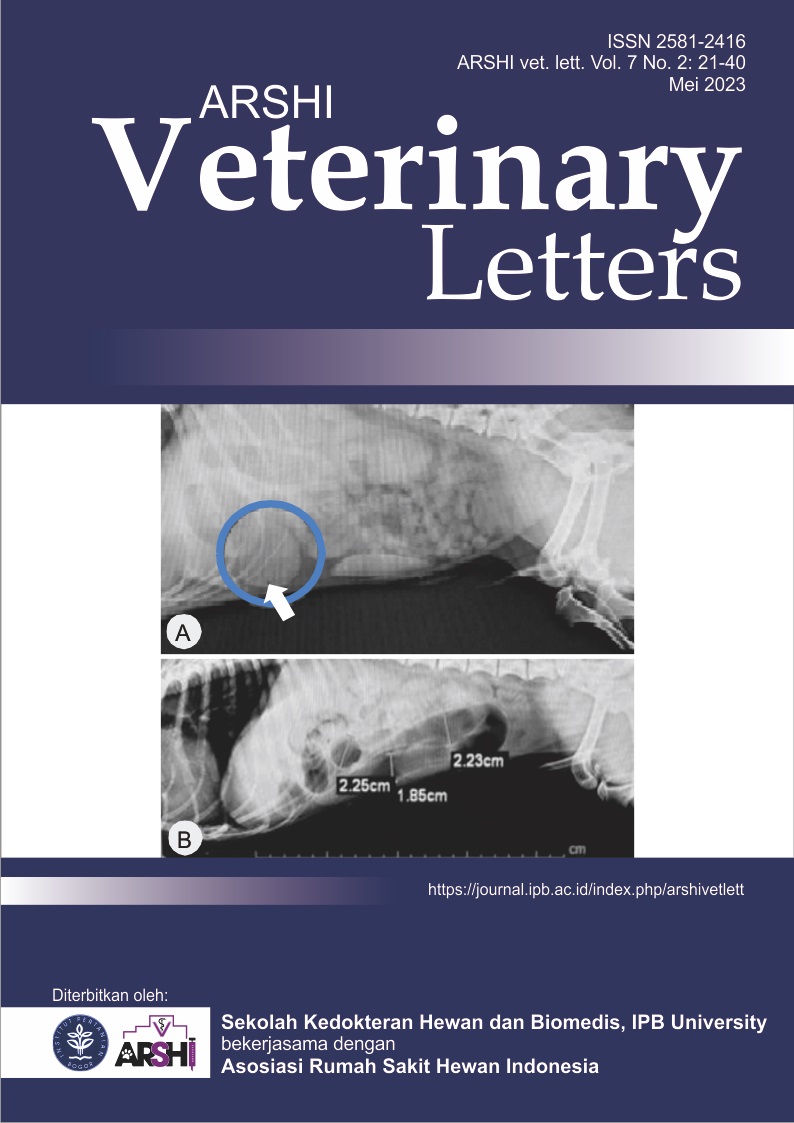Studi awal memperbaiki daya kerja pembiusan kombinasi akupunktur dan obat bius dari aspek klinis pada domba
Abstract
Kombinasi daya kerja akupunktur dengan obat bius pada domba sebagai pengobatan alternatif dalam menangani berbagai kasus operasi di lapangan. Penelitian ini bertujuan untuk menilai efektifitas kerja kombinasi obat bius dan akupunktur dalam terhadap daya kerja pembiusan pada domba. Domba sebanyak 10 ekor dibius dengan 4 kombinasi dari 3 agen bius yaitu obat bius Xylazil-20® (xylazin), Nembutal® (pentobarbital) dan akupunktur dalam interval waktu tertentu. Pengamatan dilakukan berdasarkan aspek klinis seperti suhu, frekuensi jantung dan respirasi. Kelompok kombinasi perlakuan pembiusan, yaitu Xylazil-20® dan Akupunktur, Nembutal® dan Akupunktur, Akupunktur dan Xylazil20®, serta Akupunktur dan Nembutal®. Setiap kelompok terbagi 2 tahap dalam 6 stadium yaitu tahap pertama Preanestesia-1, Anestesia-1, Postanestesia-1. Kemudian tahap kedua Preanestesia-2, Anestesia-2 dan Postanestesia-2. Secara umum kombinasi antara akupunktur dengan obat dapat memperbaiki daya kerja dan efisiensi pembiusan. Pembiusan dengan perlakuan awal obat bius, dilanjutkan dengan akupunktur lebih baik daripada kombinasi akupunktur terlebih dahulu diikuti dengan obat bius.
Downloads
References
Ashour K, Awad NAE, Abdelgayed SS, Leil AZ, Sheta E. 2020. Comparison between electroacupuncture, detomidine plus electroacupuncture and detomidine alone for laparoscopic surgery in goats. Journal of Applied Veterinary Sciences. 5(4): 73-83.
Chu DW, Lee DT, Chan TT, Chow TL, Que MB, Kwok SP. 2003. Acupuncture anaesthesia in inguinal hernia repair. ANZ Journal of Surgery. 73(3):125-127.
Ferro ACZB, Cannolas C, Reginato JC, Luna SPL. 2022. Postoperative acupuncture is as effective as preoperative acupuncture or meloxicam in dogs undergoing ovariohysterectomy: blind randomized study. Journal of Acupuncture and Meridian Studies. 15(3):181-188.
Laksmipathi CV, Ramakrishna O, Bose AS, Haragopal V. 1984. Caesarean section in an ewe under acupuncture anaesthesia. American Journal of Acupuncture. 12(2):161-163.
Lee DC, Lee MO, Clifford OH, Morris LE. 1982. The autonomic of acupuncture and analgesic drugs on the cardiovascular system. American Journal of Acupuncture. 10(1):5-30.
Lu Z, Dong H, Wang Q, Xiong L. 2015. Perioperative acupuncture modulation: more than anaestheisa. British Journal of An-aesthesia. 115(2):183-193.
O'Boyle MA, Vajda GK. 1975. Acupuncture anaesthesia for abdominal surgery. Modern Veterinary Practice. 56(10):705-707.
Soehartono RH. 2012. The comparison between anesthesia acupuncture and anesthesia drugs which are conducted by clinical aspect in sheep. In: International Conference: Research and Application on Traditional Complementary and Alternative Medicine in Health Care (TCAM). Surakarta, Indonesia. pp 146-151.
Soehartono RH. 2017. Studi awal perbandingan anestesia aku-punktur dengan anestesia obat dari aspek gambaran darah pada domba. ARSHI Veterinary Letters. 1(1): 9-10.
Ulet GA. 1983. Acupuncture is not hypnosis: recent physiological studies. American Journal of Acupuncture. 11 (1):5-13.
Zhou J, Chi H, Cheng TO, Chen TY, Wu YY, Zhou WX, Shen WD, Yuan L. 2011. Acupuncture anesthesia for open heart surgery in contemporary China. International Journal of Cardi-ology. 150(1):12-16.
Copyright (c) 2023 CC-BY-SA

This work is licensed under a Creative Commons Attribution-ShareAlike 4.0 International License.
Authors who publish with this journal agree to the following terms:
1. Authors retain copyright and grant the journal right of first publication with the work simultaneously licensed under a Creative Commons Attribution License that allows others to share the work with an acknowledgement of the work's authorship and initial publication in this journal.
2. Authors are able to enter into separate, additional contractual arrangements for the non-exclusive distribution of the journal's published version of the work (e.g., post it to an institutional repository or publish it in a book), with an acknowledgement of its initial publication in this journal.
3. Authors are permitted and encouraged to post their work online (e.g., in institutional repositories or on their website) prior to and during the submission process, as it can lead to productive exchanges, as well as earlier and greater citation of published work (See The Effect of Open Access).


.jpg)















